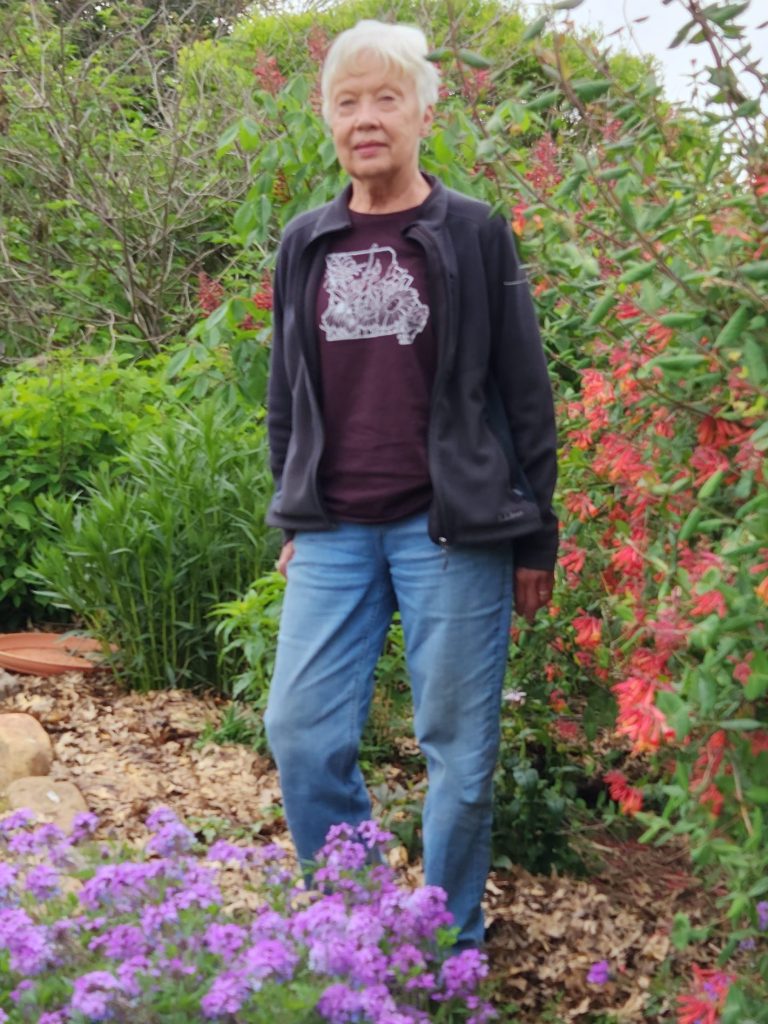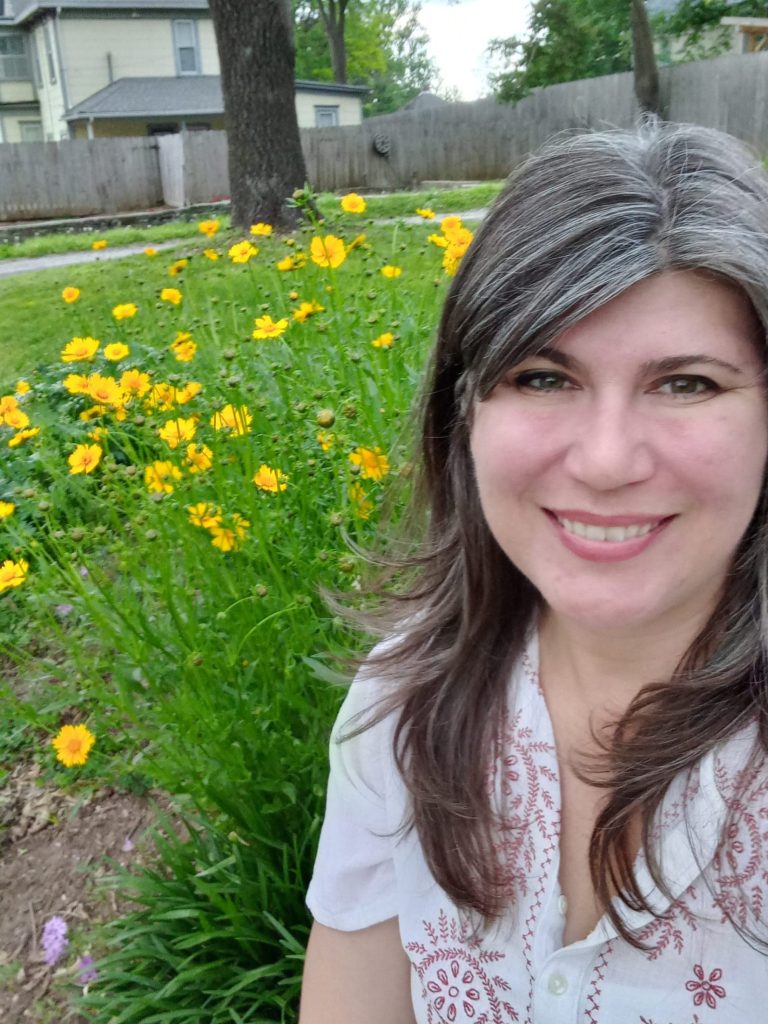Barbara Kipfer laughs as she thinks about the gardening choices she made in the early 1970s, when she and her husband, Bob, moved with their family to their southwest Springfield home.
Like many other new homes in the neighborhood, their professionally landscaped yard boasted a Callery (or Bradford) pear tree. Later, Barbara Kipfer planted a border of spike-stemmed barberry bushes — another common landscaping choice at the time — to keep their young kids from jumping into her flower garden.
“I like to say that I think I planted every invasive plant that has escaped our yard,” Kipfer joked.
Then, about 25 years ago, after a storm broke the limbs off the pear, the Kipfers decided to replace the tree with a serviceberry, a native tree the couple had often admired as it bloomed along Ozarks roadsides in the spring.
Happy in the pear’s old spot in a sunny corner of their backyard, the white-flowering tree was beautiful then — and still thrives today.
Barbara Kipfer’s love affair with native plants began long before very many were commercially available.
Now, Springfield conservationists say a growing number of gardeners show interest in planting natives, thanks to greater awareness of how they benefit pollinators and other wildlife — and the detriments of gardening with non-native, invasive plants.
For years, the Missouri Department of Conservation urged residents not to plant Bradford pears, once thought to be a sterile ornamental tree that could not reproduce. Unfortunately, that hasn’t been the case, according to Department of Conservation Community Conservation Planner Ronda Burnett, also Grow Native Committee chair. Grow Native is a native plant education program of the Missouri Prairie Foundation, which is dedicated to preserving Missouri grasslands.
Instead, Pyrus calleryana cross-pollinates with other pear cultivars, spreading and choking out native plants, Burnett said.
Nudge of the wintercreeper
An effective ground cover, wintercreeper is another invasive still commonly sold and shared among gardeners, says Brooke Widmar, education outreach coordinator for James River Basin Partnership, which promotes the use of native plants to preserve water quality.
Sadly, Euonymus fortunei isn’t content to stay on the ground. When you see a vine climbing up trees, Widmar says, “most likely that’s what you’re seeing.”
What people may not see is how wintercreeper nudges out native plants, disrupting nature’s seasonal schedule.
Near a stream where wintercreeper has taken over tree trunks, deciduous trees may not lose their leaves — leaves that would otherwise add nutrients to the stream for insects and fish, Widmar says.
More examples of invasive plants can be found on the Department of Conservation’s website entry on invasive plants.
On the other hand, conservationists say native plants have built-in ecological benefits for pollinators — the birds, bees and butterflies that depend on them to survive and thrive.
Native plants in her own backyard
Learning about those benefits motivated Kipfer, now a Department of Conservation master naturalist, to replace more invasive plants around her home and garden with natives instead.
“Part of it was finding out that it really supports a big web of wildlife that is not getting supported,” says Kipfer, “Our yards are food deserts, or worse, because of all the pesticides that are being used, as well as no food for (wildlife).”

Despite the fact more gardeners may share those concerns — not to mention the desire to glimpse monarch butterflies or spy new songbirds in their yards — they may not know how or where to work natives into home landscapes.
“A lot of people are really interested in natives,” Widmar says. “They just don’t know where to start with it.”
If a ground cover like wintercreeper, for example, is taking up space that could be used by a native sedge instead, a first step could be getting rid of the invasive plant — not always an easy task for a single gardener.
The Missouri Invasive Plant Council, another Prairie Foundation program, answers the question on its website, “Who Can Help Me Get Rid of My Invasive Plants?”
“If it’s something like a single Bradford pear, you can just cut it down and grind the stump,” Burnett said. “Some invasive species do respond to repeated treatments of herbicide, but you have to purposefully match the herbicide with the plant you’re trying to eradicate.”
She says several treatments may be needed to kill stubborn plants like Johnson grass, or sorghum halepense, once imported to stop erosion.
Planting Missouri natives a happy change
Long after her children were grown, Kipfer needed some help to dig out the barberry bushes she had planted years ago, but “when I finally got those removed to put native plants in there, it was just the happiest feeling.”
In early May, the Kipfers’ backyard is already blooming.

Along a path, yellow groundsel buds near a feathery mountain mint, Kipfer rubs a sprig between her fingers to savor the mint’s refreshing scent. Coral honeysuckle, a native alternative to invasive yellow Japanese honeysuckle, trails over a fence in a border also filled with flowers and shrubs, like blue wild indigo, red buckeye, rose verbena, rusty blackhaw and shining blue star.
“I try to have something blooming from early spring until late fall,” Kipfer said.
Trying to do too much may be a challenge for gardeners getting started with native plants. Keep it simple at first, conservationists agree. Gardens “don’t have to be 100 percent native right from the beginning,” Widmar said.
Because milkweed hosts monarchs, some may start with that, or start with a tree to provide food and shelter for wildlife, Widmar says.
The Grow Native site can help gardeners discover possibilities. It offers almost 40 lists of plants suitable for purposes, ranging from attracting ruby-throated hummingbirds to building a rain garden. It also has plans for formal gardens as well as more casual-looking songbird or hummingbird gardens.
How to get started with native plants
Burnett suggests a few other ways to begin.
Try filling problem areas in a landscape with natives, matching plants to the soil type found in those spots. That’s what she has done at her home in Springfield’s Grant Beach neighborhood, where a tiny hill next to the sidewalk made mowing the lawn a hassle.

“I wanted a native plant solution that would help me not have to mow that part of my yard,” she said.
Now, a showy stand of yellow lanceleaf coreopsis covers that hill instead.
Burnett also suggests gardeners simply start with a few native plants that catch their eye. Peruse databases at Grow Native and the Missouri Botanical Gardens; or check out the Missouri Wildflowers Nursery’s catalog, she said.
“As an exercise, maybe look through and choose one (plant) of every kind,” Burnett said. “And just kind of put together your little dream team.”
Kipfer got help from Ozark Soul, an Ozark County native plant nursery owned by horticulturists David and Jenny Middleton.
Talking to local nursery owners and growers is also one of Burnett’s favorite ways to learn about native plants, she adds. Often, growers can be found at plant sales, some of which are listed on the Grow Native site. On May 27, the Prairie Foundation will host a plant sale at Mother’s Brewing Co., 215 S. Grant Ave., from 2-6 p.m.
Experts agree that cultivating patience can also be important when getting started with native plants. Depending on their size, natives may not provide the instant swaths of showy color of the half-gallon or gallon-size annuals and perennials purchased at big-box nurseries.
“The first year they sleep, the second year they creep, and the third year they leap,” Widmar said, repeating a saying that describes how natives spend most of their early energy by establishing themselves, blooming sparsely before they reappear the third year, covered in blossoms.
Low maintenance plants
For their part, natives are fairly carefree. They need no fertilizer and little water — provided they like their new beds. Before planting, gardeners need to pay attention and “select the right plant for the right place,” Burnett said.
“Think about sunlight, how dry and rocky the soil is, if it has a lot of clay content, the amount of rain — not just the amount of rain but how long rain sets on the property,” Burnett said. “Just an awareness of your site conditions will help you choose plants that are going to thrive.”
Amending the soil isn’t necessary, Burnett said, and Widmar explained fertilizing natives can cause them to send energy into stems, not roots, so that isn’t a good idea.
Even regular watering matters only as natives are getting established, Widmar says.
For gardeners in love with native plants, there’s not much to dislike about them.
While house-hunting, Widmar said she saw purple blazing star blooming at her Springfield home and “took that as my sign that this was my house because it already had the native plants.”
For Burnett, the natives she planted at her home of five years create a beautiful landscape she enjoys, she says.
And as she watches more birds, butterflies and moths frequent her yard, she also feels proud to be doing her part for the ecosystem.
“I just really do feel that sense of accomplishment, that I am creating more of an ecological web of life in my yard,” Burnett said.


